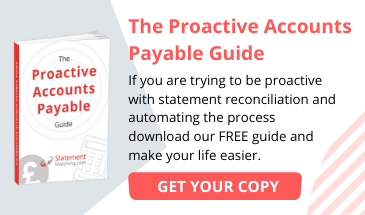Supplier statement reconciliation is a key part of the work of the accounts payable department and is essential for the fluid operation of the business. As cloud technology evolves and more streamlined processes become available in the workplace, increasing numbers of businesses are taking advantage of automated statement reconciliation software, discovering the many benefits of adopting this approach.

Reconciling supplier statements enables a business to ensure that suppliers’ liabilities are correct, that invoices are not overlooked or duplicated, and credit notes are not missing. This process is vital to maximise profits and ensure that financial statements and reports are compiled accurately.
The process of reconciling supplier statements is not complex but, if performed manually, can be time-consuming and error-prone. The supplier’s credit control department send a statement of account, including unpaid invoices, to the buyer’s accounts payable team. The statement is compared to the accounts payable ledger to identify if there are any differences.
Despite the straightforward nature of the process, manually attempting to reconcile supplier statements poses a few challenges for the accounts payable team:
Manual reconciliation is time-consuming due to the high volume of statements to be reconciled, meaning that your team are diverted from other important tasks for lengthy periods. This impacts the workflow and productivity of the team and may lead to statement reconciliation being pushed back until it becomes critical. Pushback for long enough can eventually mean missed payment deadlines and unhappy suppliers.
Supplier statement reconciliation is time-consuming, so it’s not always possible to reconcile statements on a timely basis to identify and resolve missing invoices, which contributes towards suppliers being paid late. Late settlement of invoices can incur fees and damage the buyer-supplier relationship, meaning preferential terms may be withdrawn in future.
It’s fair to say that manually reconciling lengthy suppliers’ statements is not an enjoyable task! Unfortunately, accounts payable staff are only human and therefore liable to make mistakes, especially when the task is lengthy and tedious.
Understandably, the process is sometimes pushed back and only completed when accounts are close to deadline, or even on stop. Manually reconciling accounts is likely to mean errors are not spotted in a timely manner, making it harder to balance the books later.
By contrast, businesses who make the switch to using automated statement reconciliation software experience less of these problems, and enjoy a streamlined, more accurate and more proactive process. Team members can be more productively deployed within the AP department, discrepancies and errors are identified much earlier, enabling prompt resolution, and relationships with suppliers are strengthened by prompt payments and fewer queries.
For a free demonstration of our Statement Matching software, or to find out how our cloud-based software could benefit your business, get in touch today!

Book a live demo to see the end-to-end processes on live customers systems and learn how easy it is to try this for free on a Proof of Concept.
Book a Live Demo to see the end-to-end processes on live customers systems and learn how easy it is to try this for free on a Proof of Concept.
